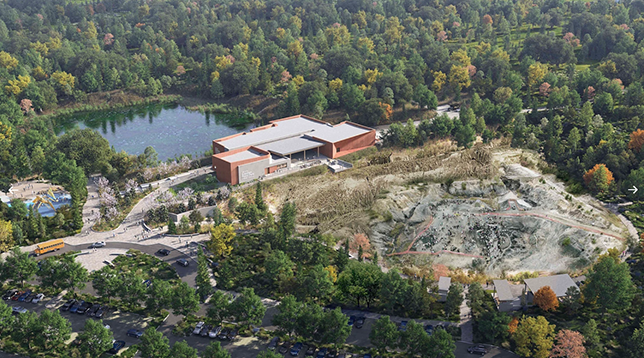Rowan U to Build $73M Fossil Park Museum
- By Dian Schaffhauser
- 10/26/21
A New Jersey university has just broken ground on the site of a new museum that is intended to explore the ancient natural past of the area while consuming net-zero energy. Rowan University's new Jean & Ric Edelman Fossil Park Museum was inspired, university officials said, by the deep-time perspective that the fossil record offers.
The 44,000-square-foot museum will sit in the 65-acre Edelman Fossil Park, perched above a four-acre former mud quarry where marine and terrestrial fossils record the last "moments" of the dinosaur world.
Research at the site is being led by Kenneth Lacovara, founding dean of Rowan's School of Earth & Environment and director of the fossil park. The work is examining what happened during the world's "fifth mass extinction," in which dinosaurs and three-quarters of other species went extinct about 66 million years ago.
The university acquired the site in 2015.

Photo credit: Ennead Architects and KSS Architects
The new $73-million museum will "transport" guests back to an era when dinosaurs roamed the coastline and massive reptilian mosasaurs, sea turtles and crocodiles populated the sea. Land and sea galleries will introduce visitors to the Dryptosaurus, the first discovered tyrannosaur, which was uncovered a mile from the park site in 1866, and a 53-foot mosasaur, like one discovered at the site, "that swam through the seas, right where you are sitting," Lacovara said in a university article about the project.
The "hall of cretaceous seas" will display marine recreations, and the "hall of extinction & hope" will share the experience of the demise of the dinosaurs, while imparting insights about the current climate change and biodiversity crises.
The new structure will use geothermal, water-source heating and cooling systems and be powered by a photovoltaic solar field, making the museum the state's largest public net-zero building.
"We are building a museum like no other, on a fossil site of global importance that will connect visitors to the ancient past, to the thrill of discovery and to Rowan University," Lacovara said.
The facility will offer hands-on learning stations and a "critter cove," containing contemporary sea and land animals with genetic connections to the site during the Late Cretaceous era. There will also be a fossil research workshop, a virtual reality chamber, a café and museum store, and a dinosaur-themed playground.
The site is named for alumni Ric and Jean Edelman, who gave $25 million to Rowan shortly after the university's purchase of the site. The intent of the donation was to develop a research ecosystem that would support scientific, undergraduate and "citizen science" opportunities.
The site has long hosted visitors, including school kids on field trips, all of whom are encouraged to find Late Cretaceous-era fossils in the park.
An economic impact study has projected that 200,000 or more fossil hunters will visit the park and museum each year, generating some $300 million in economic activity over a 10-year period.
"The impact this project will have on our region cannot be overstated," said Rowan University President Ali A. Houshmand. "From educational and research opportunities to jobs and tourism, every dollar spent developing the fossil park and museum will return to the community many times over."
Expected to open in May 2023, the museum, its landscaping and visitor experiences are being designed by Ennead Architects, KSS Architects, SEED Design, Yaki Miodovnik and Gallagher & Associates.
About the Author
Dian Schaffhauser is a former senior contributing editor for 1105 Media's education publications THE Journal, Campus Technology and Spaces4Learning.